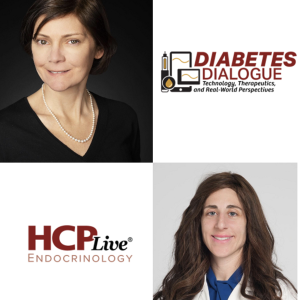
Diabetes Dialogue: Technology, Therapeutics, & Real-World Perspectives
Health & Fitness:Medicine

CATALYST Trial and Hypercortisolism in T2D, with John Buse, MD, PhD
 2024-08-02
2024-08-02
Download
Right click and do "save link as"
Even with the second half of the trial yet to be completed, results of the CATALYST trial have initiated a potentially seismic shift in discussions around the management of type 2 diabetes.
With the first part of the trial suggesting approximately 1-in-4 patients with difficult-to-control type 2 diabetes, results suggest hypercortisolism could be an underlying driver of suboptimal disease management for millions of people with type 2 diabetes in the US. Now, with this knowledge in hand, the community waits with bated breath for Corcept Therapeutics’ announcement of results from the second half of the trial, which assessed the use of mifepristone (Korlym) by randomizing patients who were diagnosed with hypercortisolism in a 2:1 ratio to mifepristone or placebo therapy.
Principal investigator John Buse, MD, PhD, chief of the Division of Endocrinology and the director of the University of North Carolina’s Diabetes Care Center, Buse and fellow investigators presented full data from the first half of the prevalence trial at the 84th American Diabetes Association Scientific Sessions
The first half of CATALYST was designed to assess the prevalence of hypercortisolism among 1000 patients from 36 study sites. For inclusion in the study, patients needed to have an HbA1c greater than 7.5% despite receiving optimal therapies. Of note, the trial defined optimal therapies for type 2 diabetes as 3 or more antihyperglycemic agents or 2 or taking insulin and other antihyperglycemic agents. Once identified, participants were required to complete a dexamethasone suppression test. If the values from this test were greater than 1.8 µg/dL and dexamethasone levels were greater than 140 ng/dL, these patients were considered as having hypercortisolism.
Results indicated the prevalence of hypercortisolism among patients with difficult-to-control type 2 diabetes was 24% (n=253 of 1055; 95% CI, 21.4 to 26.7). Buse highlighted 35.4% of those with hypercortisolism were taking 3 or more antihypertensive medications and were more likely to have cardiovascular risk relative to those without hypercortisolism.
In this episode, Buse joins hosts to discuss the trial background, expected prevalence, reaction to results, and the importance of the second part of the trial as the community moves into the future with knowledge of the true prevalence of hypercortisolism in difficult-to-control type 2 diabetes.
Chapters
00:00 - Introduction and background on Dr. John Buse and his practice
01:08 - Overview of the CATALYST trial
02:09 - Surprising results from the screening phase
07:36 - Characteristics of patients who tested positive
12:36 - Implications for clinical practice and potential changes to screening guidelines
15:52 - Hypothesized benefits of mifepristone treatment and plans for presenting the results
With the first part of the trial suggesting approximately 1-in-4 patients with difficult-to-control type 2 diabetes, results suggest hypercortisolism could be an underlying driver of suboptimal disease management for millions of people with type 2 diabetes in the US. Now, with this knowledge in hand, the community waits with bated breath for Corcept Therapeutics’ announcement of results from the second half of the trial, which assessed the use of mifepristone (Korlym) by randomizing patients who were diagnosed with hypercortisolism in a 2:1 ratio to mifepristone or placebo therapy.
Principal investigator John Buse, MD, PhD, chief of the Division of Endocrinology and the director of the University of North Carolina’s Diabetes Care Center, Buse and fellow investigators presented full data from the first half of the prevalence trial at the 84th American Diabetes Association Scientific Sessions
The first half of CATALYST was designed to assess the prevalence of hypercortisolism among 1000 patients from 36 study sites. For inclusion in the study, patients needed to have an HbA1c greater than 7.5% despite receiving optimal therapies. Of note, the trial defined optimal therapies for type 2 diabetes as 3 or more antihyperglycemic agents or 2 or taking insulin and other antihyperglycemic agents. Once identified, participants were required to complete a dexamethasone suppression test. If the values from this test were greater than 1.8 µg/dL and dexamethasone levels were greater than 140 ng/dL, these patients were considered as having hypercortisolism.
Results indicated the prevalence of hypercortisolism among patients with difficult-to-control type 2 diabetes was 24% (n=253 of 1055; 95% CI, 21.4 to 26.7). Buse highlighted 35.4% of those with hypercortisolism were taking 3 or more antihypertensive medications and were more likely to have cardiovascular risk relative to those without hypercortisolism.
In this episode, Buse joins hosts to discuss the trial background, expected prevalence, reaction to results, and the importance of the second part of the trial as the community moves into the future with knowledge of the true prevalence of hypercortisolism in difficult-to-control type 2 diabetes.
Chapters
00:00 - Introduction and background on Dr. John Buse and his practice
01:08 - Overview of the CATALYST trial
02:09 - Surprising results from the screening phase
07:36 - Characteristics of patients who tested positive
12:36 - Implications for clinical practice and potential changes to screening guidelines
15:52 - Hypothesized benefits of mifepristone treatment and plans for presenting the results
More Episodes
Real-World Experience with Dexcom Stelo
 2024-09-11
2024-09-11
 2024-09-11
2024-09-11
Navigating ADCES 2024
 2024-08-19
2024-08-19
 2024-08-19
2024-08-19
Blue Circle Health, with Monica Gomberg, MD
 2024-07-18
2024-07-18
 2024-07-18
2024-07-18
ADA 2024 Diabetes Technology Recap
 2024-07-18
2024-07-18
 2024-07-18
2024-07-18
GLAM and CRISTAL, Updates in Pregnancy
 2024-06-05
2024-06-05
 2024-06-05
2024-06-05
2024 ACP Type 2 Diabetes Recommendations
 2024-04-20
2024-04-20
 2024-04-20
2024-04-20
01234567910111213141516171819
Create your
podcast in
minutes
- Full-featured podcast site
- Unlimited storage and bandwidth
- Comprehensive podcast stats
- Distribute to Apple Podcasts, Spotify, and more
- Make money with your podcast
It is Free
- Privacy Policy
- Cookie Policy
- Terms of Use
- Consent Preferences
- Copyright © 2015-2024 Podbean.com




